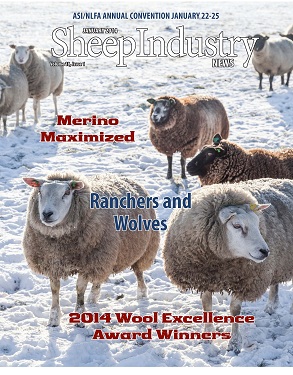
- January 2014
- President’s Notes
- Market Report
- Mackenzie, Lunsford Earn Wool Excellence Awards
- Lamb Nutrition, Industry Research Helps Creamery Grow
- NDSU Hosts Shearing, Classing Schools
- Can Southwest Ranchers Find Peace With Wolves in Their Midst?
- Merino Maximized
- Snapshot 2014: Cornerstone Updates its Efforts on Behalf of ASI, Sheep Producers
- Idaho Ranchers Chip in for Wolf Control
- USDA Releases Report on Sheep Health
- Sheep Trailing Tradition Failing
- Site’s Goal is to Link Growers to Landowners
- Obituaries
USDA Releases Report on Sheep Health
The U.S. Department of Agriculture’s Animal and Plant Health Inspection Service (APHIS) released the third descriptive report from its Sheep 2011 Study (Part III): Health and Management Practices on U.S. Sheep Operations, 2011. The report was produced by APHIS’s National Animal Health Monitoring System (NAHMS).
The NAHMS Sheep 2011 study was conducted in 22 of the nation’s major sheep-producing states and marks the first time in 10 years that NAHMS has taken an in-depth look at the U.S. sheep industry. The study provides participants, stakeholders and the industry with valuable information representing 70.1 percent of U.S. farms with ewes and 85.5 percent of the U.S. ewe inventory.
Some of the reports highlights include:
• Nearly half of all operations (47.3 percent) calculated lambing rate by determining the number of lambs born divided by ewes bred. Over half of large operations (500 or more ewes, 54.9 percent) determined lambing rate by estimating the number of lambs docked divided by the number of ewes bred.
• Overall, producers on 84.8 percent of operations were either very or somewhat familiar with scrapie. Of these, about half (47.3 percent) implemented genetic selection for scrapie control and, of these, almost all (98.8 percent) used replacement rams genetically less susceptible (RR alleles) to scrapie.
• Toxoplasmosis and coxiellosis (Q fever) are common causes of abortion storms in sheep flocks, yet producers on 28.5 and 52 percent of operations had not heard of toxoplasmosis and Q fever, respectively.
• Overall, 81.6 percent of operations used vaccines in 2010. The highest percentage of operations vaccinated against enterotoxemia and tetanus (71.4 and 64.5 percent of operations, respectively). A higher percentage of herded/open range flocks vaccinated for sore mouth compared with other flock types.
• The most commonly treated illness on sheep operations was respiratory disease; for operations that gave any antibiotics, 67.7 percent treated sheep for this illness during 2010. The antibiotic class used most frequently to treat respiratory disease was penicillin (29.9 percent of operations), followed by tetracycline (19.2 percent) and florfenicol (13.6 percent).

